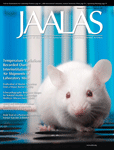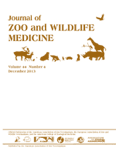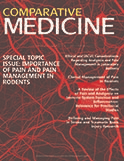
Journal of the American Association for Laboratory Animal Science
Scope & Guideline
Championing integrity and welfare in laboratory animal studies.
Introduction
Aims and Scopes
- Animal Welfare and Ethics:
The journal emphasizes the ethical treatment of laboratory animals and promotes research that enhances their welfare. This includes studies on housing, social interactions, and environmental enrichment. - Experimental Methodologies:
JAALAS publishes research on innovative methodologies and practices in laboratory animal science, including anesthesia, surgery, and health monitoring techniques. - Health Management and Disease Prevention:
Research on health management practices, disease monitoring, and pathogen control in laboratory animal facilities is a core focus, contributing to better health outcomes for research animals. - Translational Research:
The journal supports studies that facilitate the translation of research findings from animal models to human health applications, highlighting the relevance of animal research in biomedical sciences. - Education and Training:
JAALAS provides a platform for sharing best practices in the education and training of laboratory animal professionals, promoting competency and ethical standards in animal research.
Trending and Emerging
- Environmental Influences on Animal Research:
Recent publications have increasingly focused on the impact of extrinsic environmental variables, such as noise, light, and temperature, on animal welfare and research outcomes, emphasizing the importance of optimizing housing conditions. - Advanced Pain Management Techniques:
There is a growing trend towards exploring advanced pain management strategies, including the use of long-acting analgesics and novel anesthetic protocols, to improve animal welfare during and after procedures. - Integration of Technology in Animal Research:
The adoption of technology, such as deep learning for pain assessment and non-invasive monitoring techniques, is on the rise, reflecting a shift towards more innovative and efficient research methodologies. - Focus on Microbiome and Health:
Research exploring the role of the microbiome in health and disease is gaining traction, highlighting its significance in understanding animal welfare and the translational relevance of animal models. - Interdisciplinary Approaches to Animal Welfare:
Emerging themes emphasize collaboration across disciplines, integrating insights from psychology, veterinary science, and ethics to enhance animal welfare practices in research settings.
Declining or Waning
- Traditional Euthanasia Methods:
Research focused on conventional euthanasia techniques, such as CO2 euthanasia, has decreased as newer, more humane methods are developed and adopted. - Basic Pharmacokinetics Studies:
There has been a noticeable decline in publications centered solely on basic pharmacokinetics, as the field shifts towards more complex, integrative studies that consider pharmacodynamics and clinical relevance. - Non-invasive Monitoring Techniques:
Interest in older non-invasive monitoring methods has waned as advancements in technology have led to the development of more sophisticated and accurate monitoring systems. - Behavioral Studies in Controlled Settings:
The number of studies investigating animal behavior in highly controlled laboratory settings has decreased, possibly due to a growing emphasis on naturalistic or semi-natural environments for research. - Historical Perspectives on Animal Models:
Research that focuses on historical perspectives or retrospective analyses of animal models has become less prominent, as the journal prioritizes current methodologies and future directions.
Similar Journals

Journal of Veterinary Science
Connecting Researchers to Transform Veterinary Medicine.Journal of Veterinary Science, published by the Korean Society of Veterinary Science, is a distinguished peer-reviewed Open Access journal that has been contributing to the field of veterinary medicine since its inception in 2000. With an E-ISSN of 1976-555X, this journal not only provides critical insights for researchers globally but also maintains a strong presence within the academic community, evidenced by its impressive ranking in the Scopus database, where it stands at 44 out of 194 in the general veterinary category, placing it in the 77th percentile. The journal’s impact factor reflects its rigorous standards and the significance of the research it publishes, all while offering unrestricted access to its content since 2006, which promotes the free exchange of knowledge. Situated in the vibrant academic atmosphere of Seoul, South Korea, the Journal of Veterinary Science aims to advance veterinary research and practice, covering a broad spectrum of topics to inspire students, professionals, and established researchers alike to push the boundaries of veterinary science.

JOURNAL OF ZOO AND WILDLIFE MEDICINE
Championing the health of wildlife and zoo species.JOURNAL OF ZOO AND WILDLIFE MEDICINE, published by the American Association of Zoo Veterinarians, serves as a pivotal resource in the field of veterinary science, focusing specifically on the health and well-being of zoo and wildlife species. With an ISSN of 1042-7260 and an E-ISSN of 1937-2825, this journal is recognized for its significant contributions to animal science and has been categorized in the second quartile in both Animal Science and Zoology, as well as Veterinary disciplines, according to the latest rankings. It holds a respectable position within Scopus, being ranked #91 in General Veterinary and #290 in Animal Science and Zoology. While the journal operates on a subscription basis, its impactful research articles have been invaluable for clinicians, researchers, and students alike, providing crucial insights that advance wildlife conservation, veterinary practices, and animal health care from 1993 to the present. With a global reach and a targeted focus on both theoretical and practical applications, JOURNAL OF ZOO AND WILDLIFE MEDICINE is instrumental in fostering collaboration among professionals dedicated to the study and care of wild animal populations.

TURKISH JOURNAL OF VETERINARY & ANIMAL SCIENCES
Exploring Innovations in Animal Health and Welfare.TURKISH JOURNAL OF VETERINARY & ANIMAL SCIENCES is a distinguished peer-reviewed journal dedicated to advancing knowledge in the field of veterinary sciences and animal health. Published by the Tubitak Scientific & Technological Research Council Turkey, this journal provides a platform for high-quality research, fostering scientific inquiry that spans various aspects of veterinary medicine, animal biology, and animal husbandry. With an impact factor that reflects its growing influence within the Q3 category of Veterinary (miscellaneous) according to the 2023 rankings, it is strategically positioned in the academic landscape, ranked #112 out of 194 in the broader veterinary field. The journal is committed to open access publications, ensuring that research is accessible to a global audience, facilitating collaboration and knowledge sharing among researchers, professionals, and students. By covering a broad spectrum of topics from clinical research to veterinary policy, the TURKISH JOURNAL OF VETERINARY & ANIMAL SCIENCES plays a crucial role in enhancing the understanding and welfare of animal species, thereby contributing significantly to both scientific advancement and practical applications in veterinary practice.

ANIMAL SCIENCE JOURNAL
Bridging Theory and Practice in Animal ResearchAnimal Science Journal, published by Wiley, stands as a premier platform for advancing knowledge in the fields of Agricultural and Biological Sciences, Animal Science and Zoology, and Food Science. With an ISSN of 1344-3941 and an E-ISSN of 1740-0929, this journal not only enjoys a commendable Q2 ranking across multiple categories, reflecting its significance and impact within the academic community, but it also ranks within the top percentiles in terms of Scopus rankings. Operating out of the United Kingdom, the journal covers a broad spectrum of research topics relevant to animal science, encompassing both theoretical insights and practical applications. While it is not an open access journal, it remains an essential resource for researchers and practitioners eager to enhance their understanding of animal sciences, contribute to ongoing debates, and stay abreast of the latest findings from 2003 through 2024. Scholar engagement and innovative research are central to the journal’s objectives, making it an invaluable asset for students, professionals, and academics alike.

ISRAEL JOURNAL OF VETERINARY MEDICINE
Exploring Innovations in Animal Health and ScienceThe Israel Journal of Veterinary Medicine, published by the Israel Veterinary Medical Association, serves as a vital resource for researchers, professionals, and students in the fields of veterinary medicine and animal science. With a commitment to advancing knowledge across diverse veterinary disciplines, this journal plays a crucial role in disseminating significant findings and innovations that influence both local and global veterinary practices. Although it currently holds a Q4 ranking in both the Animal Science and Zoology and Veterinary (miscellaneous) categories, the journal's open access policy, enabling free availability of articles, aspires to increase its accessibility and engagement among the academic community. The journal's convergence of research from 2007 to 2024 showcases its dedication to continuously contributing to the evolving landscape of veterinary science.

COMPARATIVE MEDICINE
Bridging disciplines for a healthier tomorrow.Comparative Medicine, published by the American Association for Laboratory Animal Science, serves as a vital resource in the fields of veterinary science and biochemistry, focusing on the complexities of laboratory animal research and its implications for human and animal health. Established in 2000 and continuing through 2024, this journal has cultivated a reputation for disseminating innovative research and reviews that enhance understanding of comparative biology and medicine. With a commendable Q3 rank in both Biochemistry, Genetics and Molecular Biology and Medicine, and a notable Q2 rank in Veterinary sciences as of 2023, it stands out in its field. The journal is dedicated to open access, aligning with contemporary trends in scientific communication, and its impact can be appreciated in its Scopus ranks, placing it in the 59th percentile for General Veterinary and the 36th percentile for General Biochemistry, Genetics, and Molecular Biology. Researchers, professionals, and students will find this journal indispensable for staying informed on cutting-edge advancements and fostering cross-disciplinary dialogue in comparative medicine.

AUSTRAL JOURNAL OF VETERINARY SCIENCES
Connecting Scholars to Transform Veterinary ScienceAUSTRAL JOURNAL OF VETERINARY SCIENCES is a prominent platform for innovative research in the field of veterinary science, published by UNIV AUSTRAL CHILE, FAC CIENCIAS VETERINARIAS. This journal, bearing the ISSN 0719-8000 and E-ISSN 0719-8132, serves as a vital resource for researchers, veterinarians, and students interested in advancing their knowledge in veterinary practices and animal health. With its influence reflected in its Q3 category ranking in the Veterinary (miscellaneous) field, and its Scopus rank of #95 out of 194, the journal highlights a robust commitment to disseminating valuable findings and insights. Between the years 2017 to 2024, it aims to provide open access to significant advancements and discussions in veterinary science, ensuring that vital research is accessible to a global audience. Located in Valdivia, Chile, the journal emphasizes its role in enhancing veterinary scholarship and fostering professional development within the community.

Porcine Health Management
Empowering veterinary science for healthier pigs.Porcine Health Management is an esteemed open-access journal published by BMC, focusing on the critical intersection of veterinary science and animal husbandry with a particular emphasis on swine health. Since its inception in 2015, the journal has established itself as a leading platform for disseminating cutting-edge research, earning a prominent position in the field with a 2023 category ranking of Q1 in Animal Science and Zoology, Food Animals, and Small Animals. With a strong impact factor indicative of its quality and relevance, the journal serves as an essential resource for researchers, practitioners, and students dedicated to advancing knowledge in swine health management. It is hosted in the United Kingdom and operates under transparent open-access guidelines, providing broad accessibility to vital research findings that drive innovation in animal health practices. As the field continues to evolve, Porcine Health Management remains at the forefront, contributing to the welfare and productivity of food animals.

Slovenian Veterinary Research
Enhancing Accessibility to Cutting-Edge Veterinary StudiesSlovenian Veterinary Research, published by the University of Ljubljana, serves as a significant platform for the dissemination of research within the veterinary field. With an ISSN of 1580-4003 and an E-ISSN of 2385-8761, this open-access journal has made its content freely available to the global research community since 2021, enhancing accessibility and engagement. The journal's scope includes a diverse range of topics relevant to veterinary science, aiming to foster innovation and collaboration among researchers, professionals, and students in the field. Although currently categorized in the Q4 quartile for veterinary studies, the journal is committed to improving its impact and visibility, particularly as it converges on its upcoming years of operation from 2007 to 2024. As it strives to elevate its Scopus ranks, currently positioned at rank #162/194 in General Veterinary, Slovenian Veterinary Research provides a vital resource for advancing knowledge and best practices in veterinary medicine. For anyone interested in the latest veterinary research trends and findings emanating from Slovenia and beyond, this journal represents an essential source of information.

LABORATORY ANIMALS
Exploring the intersection of science and ethics in animal research.LABORATORY ANIMALS is a premier journal published by SAGE PUBLICATIONS INC, dedicated to advancing the field of laboratory animal science. With an impressive impact factor that places it in the Q1 quartile for both Animal Science and Zoology, and Veterinary disciplines, it ranks remarkably at #13 out of 194 in General Veterinary and #62 out of 490 in Animal Science on Scopus. Established in 1970 and set to continue its trajectory until 2024, the journal covers a wide range of topics relevant to researchers, professionals, and students interested in the ethical and scientific use of laboratory animals. Although it operates under a traditional subscription model, its high-quality publications provide essential insights into veterinary practices, animal welfare, and translational research. The journal serves not only as a critical resource for contemporary research but also as a platform for dialogue on best practices in laboratory animal care, making it indispensable for anyone invested in the advancement of veterinary and animal sciences.